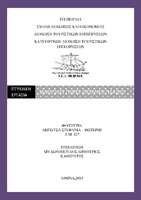| dc.contributor.advisor | Μυλωνόπουλος, Δημήτριος | |
| dc.contributor.author | Λεγκίτσα, Στεφανία - Φωτεινή | |
| dc.date.accessioned | 2014-05-16T13:50:27Z | |
| dc.date.available | 2014-05-16T13:50:27Z | |
| dc.date.issued | 2014 | |
| dc.identifier.uri | http://okeanis.lib2.uniwa.gr/xmlui/handle/123456789/1596 | |
| dc.description.abstract | Στις επόμενες σελίδες της εργασίας θα περιγράψουμε την σημασία και τη
χρησιμότητα των ελληνικών ιαματικών πηγών για την σωματική και ψυχική υγεία
του ανθρώπου,καθώς και τις ιδιότητες αυτών.
Η ιστορία των ιαματικών πηγών αρχίζει από την αρχαία Ελλάδα. Ο πρώτος
παρατηρητής των πηγών αυτών ήταν ο ιστορικός Ηρόδοτος (484- 410 π.Χ.), που
περιέγραψε ορισμένες ιαματικές πηγές και συνιστούσε η λουτροθεραπεία να γίνεται
σε ορισμένες εποχές και για 21 συνεχόμενες ημέρες. Ο Ιπποκράτης από την Κω
όμως, ήταν ο εκείνος που θεωρήθηκε ο πατέρας της υδροθεραπείας. Ασχολήθηκε με
διάφορα νερά και τα διέκρινε (α) σε ελώδη: δηλαδή τα νερά που υπάρχουν στα έλη
και τις λίμνες, (β) σε όμβρια: τα νερά που σχηματίζονται από τη βροχή και (γ) σε
μεταλλικά: εκείνα δηλαδή που αναβλύζουν από πετρώματα.
Τα μεταλλικά ύδατα κατηγοριοποιούνται ανάλογα με τα φυσικοχημικά συστατικά
που περιέχονται, τη θερμοκρασία του ύδατος υπό του εδάφους και του επιφανειακού
περιβάλλοντος και φυσικά από το καθορισμένο ποσό ραδιενέργειας.
Η προέλευση των υδάτων χωρίζεται σε ενδογενή και σε εξωγενή προέλευση και
φυσικά βάσει των συστατικών τους που και αυτά χωρίζονται σε αέρια και στερεά
συστατικά.
Αναλύοντας τις κυριότερες ιαματικές πηγές ανακαλύπτουμε την ιστορία της κάθε
πηγής, την τοποθεσία της καθώς και τις εγκαταστάσεις τις οποίες έχουν. Χωρίς
εξαίρεση ο γεωγραφικός και γεωλογικός καταμερισμός των πηγών μας βοηθάει στο
να κατανοήσουμε τη σημασία της μορφολογίας του εδάφους και εν γένει της
περιοχής αυτών.
Το νομοθετικό πλαίσιο για τις πηγές εξηγεί τον τρόπο αναγνώρισής τους, την
διαδικασία, την κυριότητα και την άρση αναγνώρισης. Κάθε ιαματικός φυσικός
πόρος έχει μητρώο και προστατεύεται. Η διαχείριση ή παραχώρηση σε τρίτους και οι
άδειες εγκαταστάσεων ιαματικού τουρισμού πρέπει να έχουν συγκεκριμένες
προδιαγραφές, ώστε να τους παραχωρηθεί ειδικό σήμα λειτουργίας. Για όλες αυτές
τις διαδικασίες υπάρχει έλεγχος και αν δεν πληρούνται οι προδιαγραφές υπάρχουν
κυρώσεις.
Γι’ αυτό παίζει μεγάλο ρόλο οι άνθρωποι , οι οργανισμοί και οι επιχειρήσεις που
εκμεταλλεύονται τις ιαματικές πηγές να έχουν ενημερωθεί και οργανωθεί κατάλληλα
ώστε η χρήση της κάθε πηγής να γίνεται με τον καλύτερο δυνατό τρόπο, και ο
ασθενής που θα πηγαίνει σε αυτές θα του έχουν δοθεί οι σωστές οδηγίες για την
χρήση της και την σωστή ολοκλήρωση της θεραπείας του. Γιατί η κάθε πηγή έχει την
δική της θεραπευτική ιδιότητα και πρέπει ο καθένας να έχει αναζητήσει την πηγή που
τον ενδιαφέρει είτε μέσω γεωγραφικής αναζήτησης είτε μέσω της παθήσεως του. | el |
| dc.format.extent | 96 σελ. | el |
| dc.language.iso | el | el |
| dc.publisher | ΤΕΙ Πειραιά | el |
| dc.rights | Αναφορά Δημιουργού-Μη Εμπορική Χρήση-Όχι Παράγωγα Έργα 3.0 Ελλάδα | * |
| dc.rights.uri | http://creativecommons.org/licenses/by-nc-nd/3.0/gr/ | * |
| dc.subject | TPSH::Τουρισμός | el |
| dc.title | Ιαματικές πηγές. Θεσμικό πλαίσιο | el |
| dc.type | Πτυχιακή εργασία | el |
| dc.contributor.department | Τμήμα Τουριστικών Επιχειρήσεων | el |
| dc.contributor.faculty | Σχολή Διοίκησης και Οικονομίας | el |
| dc.subject.keyword | Ιαματικές πηγές | el |
| dc.subject.keyword | Μεταλλικά ύδατα | el |
| dc.subject.keyword | Γεωγραφικός καταμερισμός | el |
| dc.subject.keyword | Γεωλογικός καταμερισμός | el |
| dc.subject.keyword | Θεραπεία | el |
| dc.subject.keyword | Λουτροθεραπεία | el |
| dc.description.abstracttranslated | In the next pages of this thesis we will describe the meaning and the usefulness of
the Greek thermal springs for man’s physical and mental health and their properties.
The history of the thermal springs starts in ancient Greece. The first observer of
these springs was historian Hirodotos (484-410 B.C), who described some thermal
springs and suggested that bathing in them to be done in certain seasons and for 21
straight days. But Hippocrates from Ko Island, was the one considered the father of
hydropathy. He studied several kinds of spring waters and categorized them at (a)
marshy: meaning the water exists in swamps and lakes, (b) rain water: water created
through rain and (c) mineral: those that gush from ores.
Mineral water is categorized depending on its physicochemical ingredients that are
contained within it, the temperature of the water under the ground and the superficial
environment and of course from the specified amount of radiation.
The origin of the water is divided in endogenous and exogenous origin and of course
based on its ingredients which are also divided in gases and solid ingredients.
Analyzing the greatest thermal springs we discover each springs’ history, its location
and also their facilities. Without exception the geographical and geological
apportionment of the springs are helping us to understand the meaning of the ground’s
morphology and generally the area’s.
The legislative framework for the springs explains the means to identify them, the
procedure, the ownership and removing recognition. Each natural thermal resource is
registered and protected. The management or transferring to third parties and the
licenses for the facilities of spring tourism must hold certain requirements, so as to be
granted the special operation badge. All these procedures are checked and if the
requirements are not satisfied, there are penalties.
For this reason people, agencies and businesses who exploit thermal springs must be
updated and organized accordingly so that the use of each spring is done in the best
possible way, and the patient who attends them will be given correct instructions for
the use and the proper fulfillment of his cure. Because each spring has its own healing
property and everyone must search the spring he is interested in whether in a
geographically mean or his respective pathologically condition. | el |



